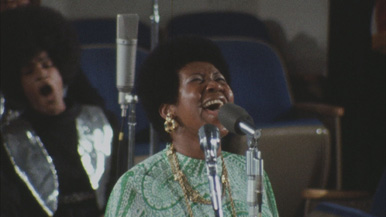|
|
Movie Review: Amazing GraceBy Matthew HuntleyApril 24, 2019
One of the most remarkable things we get to see is just how easily Franklin transforms from quiet, unassuming church-goer to impassioned leader singer. Her change is so stark and immediate, it’s as if Franklin simply turned on a switch. On one level, it’s exhilarating because she instantly seizes us with her strength and vocal range; on another, it’ mesmerizing because she makes it look so natural and seamless. In a way, the bottomless energy and enthusiasm Franklin has for her faith, which she expresses through song, is intimidating, yet also comforting and inspirational. She’s able to strike a balance between her vigorous, overwhelming intensity and her elegant style and dignity, reminding why she was so qualified to be appointed, “The Queen of Soul.” The most memorable scenes of “Amazing Grace” are, of course, those in which Franklin enchants us with her voice, including her renditions of “Amazing Grace” itself, which she lends a different rhythm from what we’re used to; “Precious Lord, Take My Hand / You’ve Got a Friend,” which is one of several songs where members of the audience dance, swing and vibrate their bodies almost uncontrollably; and “Never Grow Old,” which doesn’t bring the down the house so much as it raises it to another level. Seeing these performances on film is like experiencing a force of nature, and both Franklin and the audience members create it together. While all this would have been enough, “Amazing Grace” is also alive and calming in between its music numbers. It’s padded with tender, sincere and simply happy moments that evoke the spirit of the camaraderie. Many of these are thanks to Cleveland, a soft-spoken and jolly fellow who can tickle the ivories with the best of them. At one point, he introduces Aretha’s father, Minister C. L. Franklin, who gives an extemporaneous yet still heartfelt speech about the magnificence of his daughter (he calls her a “stone singer,” although I’m still not sure what he means by this) and recalls how a woman came up to him one night in a supermarket in his hometown of Detroit. I’m paraphrasing here, but the woman said she saw Aretha on TV and noted that while she was good, she should really get back to church, to which C.L. replied, “Baby, she never left the church.” Indeed she didn’t, because “Amazing Grace” shows an artist completely at home in her element. Aretha Franklin glows in it, and there’s something wholesome and beautiful about the way the grainy 16mm film captures her shiny hair, her squinting eyes, her white teeth, her smooth skin, all of which complement her passion. We sense this is the truest, purest, most raw version of Aretha Franklin and we can’t take our eyes off her or help but share in the spirit she generates amongst the crowd. And speaking of the crowd, we feel welcome among them, including a young Mick Jagger, who claps and bobs his head in unison with the music; and fellow gospel singer Clara Ward, who nearly faints because of all the positive praising and commotion. Franklin sings to everyone in equal measure. She’s lovely and magnetic, and she, along with Pollack and now Elliot, have bestowed upon on us a gift of a film that certainly lives up to its title.
|

|
|
|

|
Thursday, October 31, 2024
© 2024 Box Office Prophets, a division of One Of Us, Inc.


